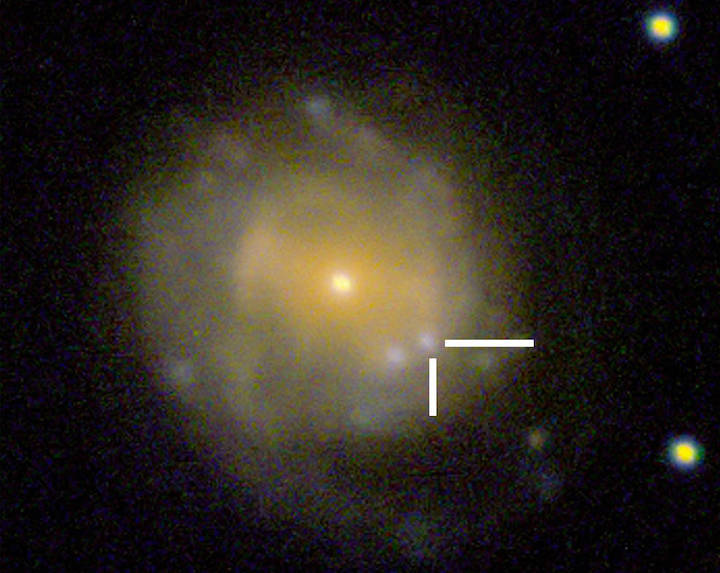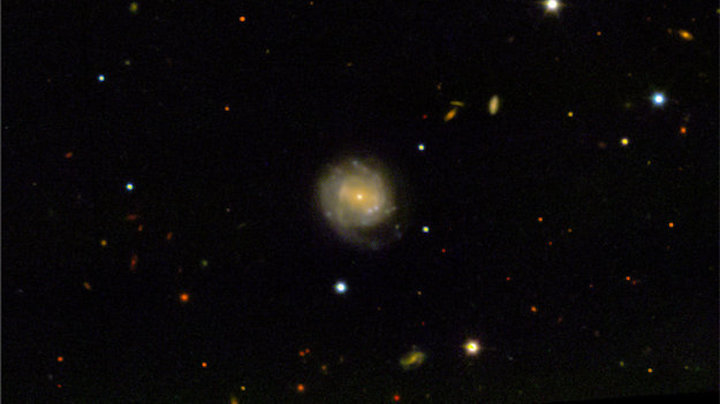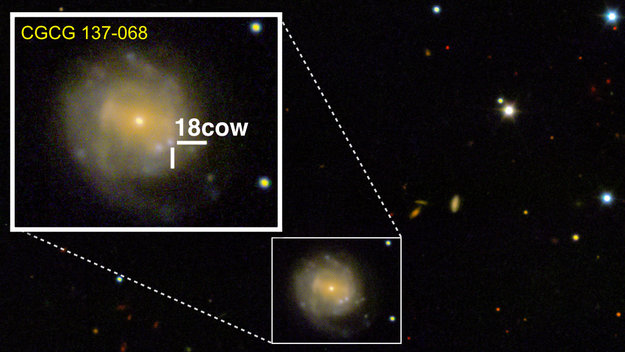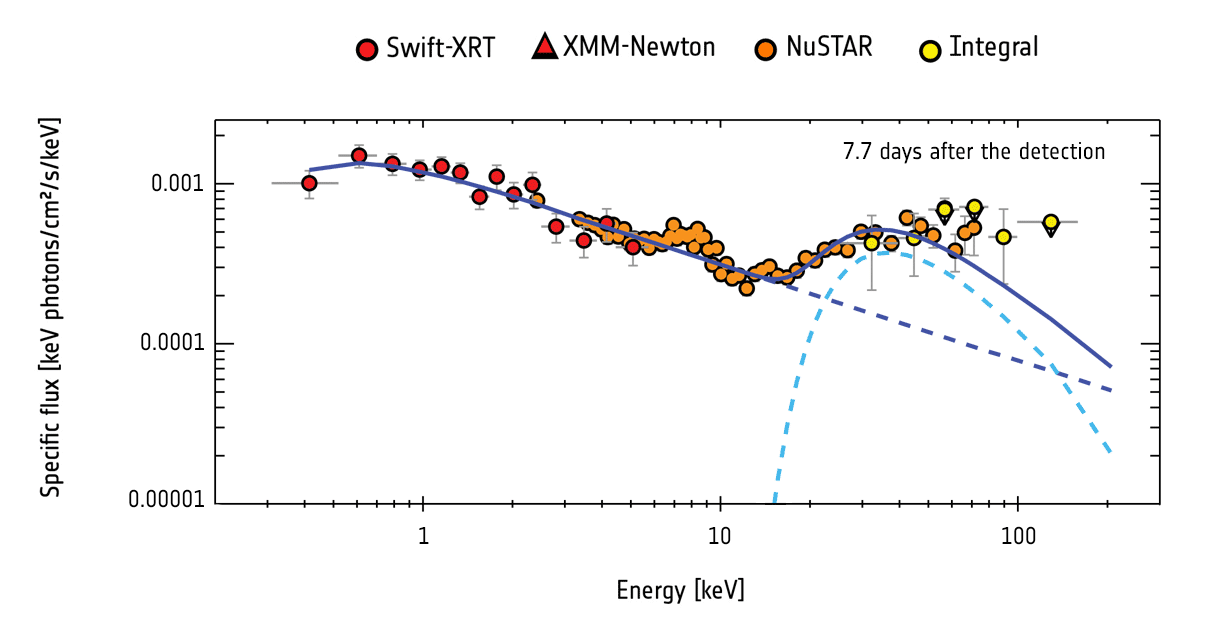11.01.2019

A brief and unusual flash spotted in the night sky on June 16, 2018, puzzled astronomers and astrophysicists across the globe. The event — called AT2018cow and nicknamed "the Cow" after the coincidental final letters in its official name — is unlike any celestial outburst ever seen before, prompting multiple theories about its source.
Over three days, the Cow produced a sudden explosion of light at least 10 times brighter than a typical supernova, and then it faded over the next few months. This unusual event occurred inside or near a star-forming galaxy known as CGCG 137-068, located about 200 million light-years away in the constellation Hercules. The Cow was first observed by the NASA-funded Asteroid Terrestrial-impact Last Alert System telescope in Hawaii.
So exactly what is the Cow? Using data from multiple NASA missions, including the Neil Gehrels Swift Observatory and the Nuclear Spectroscopic Telescope Array (NuSTAR), two groups are publishing papers that provide possible explanations for the Cow's origins. One paper argues that the Cow is a monster black hole shredding a passing star. The second paper hypothesizes that it is a supernova — a stellar explosion — that gave birth to a black hole or a neutron star.
Researchers from both teams shared their interpretations at a panel discussion on Thursday, Jan. 10, at the 233rd American Astronomical Society meeting in Seattle.
A Black Hole Shredding a Compact Star?
One potential explanation of the Cow is that a star has been ripped apart in what astronomers call a "tidal disruption event." Just as the Moon's gravity causes Earth's oceans to bulge, creating tides, a black hole has a similar but more powerful effect on an approaching star, ultimately breaking it apart into a stream of gas. The tail of the gas stream is flung out of the system, but the leading edge swings back around the black hole, collides with itself and creates an elliptical cloud of material. According to one research team using data spanning from infrared radiation to gamma rays from Swift and other observatories, this transformation best explains the Cow's behavior.
"We've never seen anything exactly like the Cow, which is very exciting," said Amy Lien, an assistant research scientist at the University of Maryland, Baltimore County and NASA's Goddard Space Flight Center in Greenbelt, Maryland. "We think a tidal disruption created the quick, really unusual burst of light at the beginning of the event and best explains Swift's multiwavelength observations as it faded over the next few months."
Lien and her colleagues think the shredded star was a white dwarf — a hot, roughly Earth-sized stellar remnant marking the final state of stars like our Sun. They also calculated that the black hole's mass ranges from 100,000 to 1 million times the Sun's, almost as large as the central black hole of its host galaxy. It's unusual to see black holes of this scale outside the center of a galaxy, but it's possible the Cow occurred in a nearby satellite galaxy or a globular star cluster whose older stellar populations could have a higher proportion of white dwarfs than average galaxies.
A paper describing the findings, co-authored by Lien, will appear in a future edition of the journal Monthly Notices of the Royal Astronomical Society.
"The Cow produced a large cloud of debris in a very short time," said lead author Paul Kuin, an astrophysicist at University College London (UCL). "Shredding a bigger star to produce a cloud like this would take a bigger black hole, result in a slower brightness increase and take longer for the debris to be consumed."
Or a New View of a Supernova?
A different team of scientists was able to gather data on the Cow over an even broader range of wavelengths, spanning from radio waves to gamma rays. Based on those observations, the team suggests that a supernova could be the source of the Cow. When a massive star dies, it explodes as a supernova and leaves behind either a black hole or an incredibly dense object called a neutron star. The Cow could represent the birth of one of these stellar remnants.
"We saw features in the Cow that we have never seen before in a transient, or rapidly changing, object," said Raffaella Margutti, an astrophysicist at Northwestern University in Evanston, Illinois, and lead author of a study about the Cow to be published in The Astrophysical Journal. "Our team used high-energy X-ray data to show that the Cow has characteristics similar to a compact body like a black hole or neutron star consuming material. But based on what we saw in other wavelengths, we think this was a special case and that we may have observed — for the first time — the creation of a compact body in real time."
Margutti's team analyzed data from multiple observatories, including NASA's NuSTAR, ESA's (the European Space Agency's) XMM-Newton and INTEGRAL satellites, and the National Science Foundation's Very Large Array. The team proposes that the bright optical and ultraviolet flash from the Cow signaled a supernova and that the X-ray emissions that followed shortly after the outburst arose from gas radiating energy as it fell onto a compact object.
Typically, a supernova's expanding debris cloud blocks any light from the compact object at the center of the blast. Because of the X-ray emissions, Margutti and her colleagues suggest the original star in this scenario may have been relatively low in mass, producing a comparatively thinner debris cloud through which X-rays from the central source could escape.
"If we're seeing the birth of a compact object in real time, this could be the start of a new chapter in our understanding of stellar evolution," said Brian Grefenstette, a NuSTAR instrument scientist at Caltech and a co-author of Margutti's paper. "We looked at this object with many different observatories, and of course the more windows you open onto an object, the more you can learn about it. But, as we're seeing with the Cow, that doesn't necessarily mean the solution will be simple."
NuSTAR is a Small Explorer mission led by Caltech and managed by JPL for NASA's Science Mission Directorate in Washington. NuSTAR was developed in partnership with the Danish Technical University and the Italian Space Agency (ASI). The spacecraft was built by Orbital Sciences Corporation in Dulles, Virginia. NuSTAR's mission operations center is at UC Berkeley, and the official data archive is at NASA's High Energy Astrophysics Science Archive Research Center. ASI provides the mission's ground station and a mirror archive. JPL is managed by Caltech for NASA.
NASA's Goddard Space Flight Center manages the Swift mission in collaboration with Penn State in University Park, the Los Alamos National Laboratory in New Mexico and Northrop Grumman Innovation Systems in Dulles, Virginia. Other partners include the University of Leicester and Mullard Space Science Laboratory of the University College London in the United Kingdom, Brera Observatory and ASI.
Quelle: NASA
----
Update; 12.01.2019
.

TEAM OF TELESCOPES FINDS X-RAY ENGINE INSIDE MYSTERIOUS SUPERNOVA
ESA’s high-energy space telescopes Integral and XMM-Newton have helped to find a source of powerful X-rays at the centre of an unprecedentedly bright and rapidly evolving stellar explosion that suddenly appeared in the sky earlier this year.
The ATLAS telescope in Hawaii first spotted the phenomenon, since then named AT2018cow, on 16 June. Soon after that, astronomers all over the world were pointing many space- and ground-based telescopes towards the newly found celestial object, located in a galaxy some 200 million light years away.
They soon realised this was something completely new. In only two days the object exceeded the brightness of any previously observed supernova – a powerful explosion of an aging massive star that expels most of its material into the surrounding space, sweeping up the interstellar dust and gases in its vicinity.
A new paper, accepted for publication in the Astrophysical Journal, presents the observations from the first 100 days of the object’s existence, covering the entire electromagnetic spectrum of the explosion from radio waves to gamma rays.
The analysis, which includes observations from ESA’s Integral and XMM-Newton, as well as NASA’s NuSTAR and Swift space telescopes, found a source of high-energy X-rays sitting deep inside the explosion.
The behaviour of this source, or engine, as revealed in the data, suggests that the strange phenomenon could either be a nascent black hole or neutron star with a powerful magnetic field, sucking in the surrounding material.
“The most exciting interpretation is that we might have seen for the first time the birth of a black hole or a neutron star,” says Raffaella Margutti of Northwestern University, USA, lead author of the paper.
“We know that black holes and neutron stars form when stars collapse and explode as a supernova, but never before have we seen one right at the time of birth,” adds co-author Indrek Vurm of Tartu Observatory, Estonia, who worked on modelling the observations.
The AT2018cow explosion was not only 10 to 100 times brighter than any other supernova previously observed: it also reached peak luminosity much faster than any other previously known event – in only a few days compared to the usual two weeks.
Integral made its first observations of the phenomenon about five days after it had been reported and kept monitoring it for 17 days. Its data proved crucial for the understanding of the strange object.
“Integral covers a wavelength range which is not covered by any other satellite,” says Erik Kuulkers, Integral project scientist at ESA. “We have a certain overlap with NuSTAR in the high-energy X-ray part of the spectrum but we can see higher energies, too.”
So while data from NuSTAR revealed the hard X-ray spectrum in great detail, with Integral the astronomers were able to see the spectrum of the source entirely, including its upper limit at soft gamma-ray energies.
“We saw a kind of a bump with a sharp cut-off in the spectrum at the high-energy end,” says Volodymyr Savchenko, an astronomer at the University of Geneva, Switzerland, who worked on the Integral data. “This bump is an additional component of the radiation released by this explosion, shining through an opaque, or optically thick, medium.”
“This high-energy radiation most likely came from an area of very hot and dense plasma surrounding the source,” adds Carlo Ferrigno, also of the University of Geneva.
Because Integral kept monitoring the AT2018cow explosion over a longer period of time, its data was also able to show that the high-energy X-ray signal was gradually fading.
Raffaella explains that this high-energy X-ray radiation that went away was the so-called reprocessed radiation – radiation from the source interacting with material ejected by the explosion. As the material travels away from the centre of the explosion, the signal gradually wanes and eventually disappears completely.
In this signal, however, the astronomers were able to find patterns typical of an object that draws in matter from its surroundings – either a black hole or a neutron star.
“This is the most unusual thing that we have observed in AT2018cow and it’s definitely something unprecedented in the world of explosive transient astronomical events,” says Raffaella.
Meanwhile, XMM-Newton looked at this unusual explosion twice over the first 100 days of its existence. It detected the lower-energy part of its X-ray emission, which, according to the astronomers, comes directly from the engine at the core of the explosion. Unlike the high-energy X-rays coming from the surrounding plasma, the lower-energy X-rays from the source are still visible.
The astronomers plan to use XMM-Newton to perform a follow-up observation in the future, which will allow them to understand the source’s behaviour over a longer period of time in greater detail.
“We are continuing to analyse the XMM-Newton data to try to understand the nature of the source,” says co-author Giulia Migliori of University of Bologna, Italy, who worked on the X-ray data. “Accreting black holes leave characteristic imprints in X-rays, which we might be able to detect in our data.”
“This event was completely unexpected and it shows that there is a lot of which we don’t completely understand,” says Norbert Schartel, ESA’s XMM-Newton project scientist. “One satellite, one instrument alone, would never be able to understand such a complex object. The detailed insights we were able to gather into the inner workings of the mysterious AT2018cow explosion were only achievable thanks to the broad cooperation and combination of many telescopes.”
Quelle: ESA




